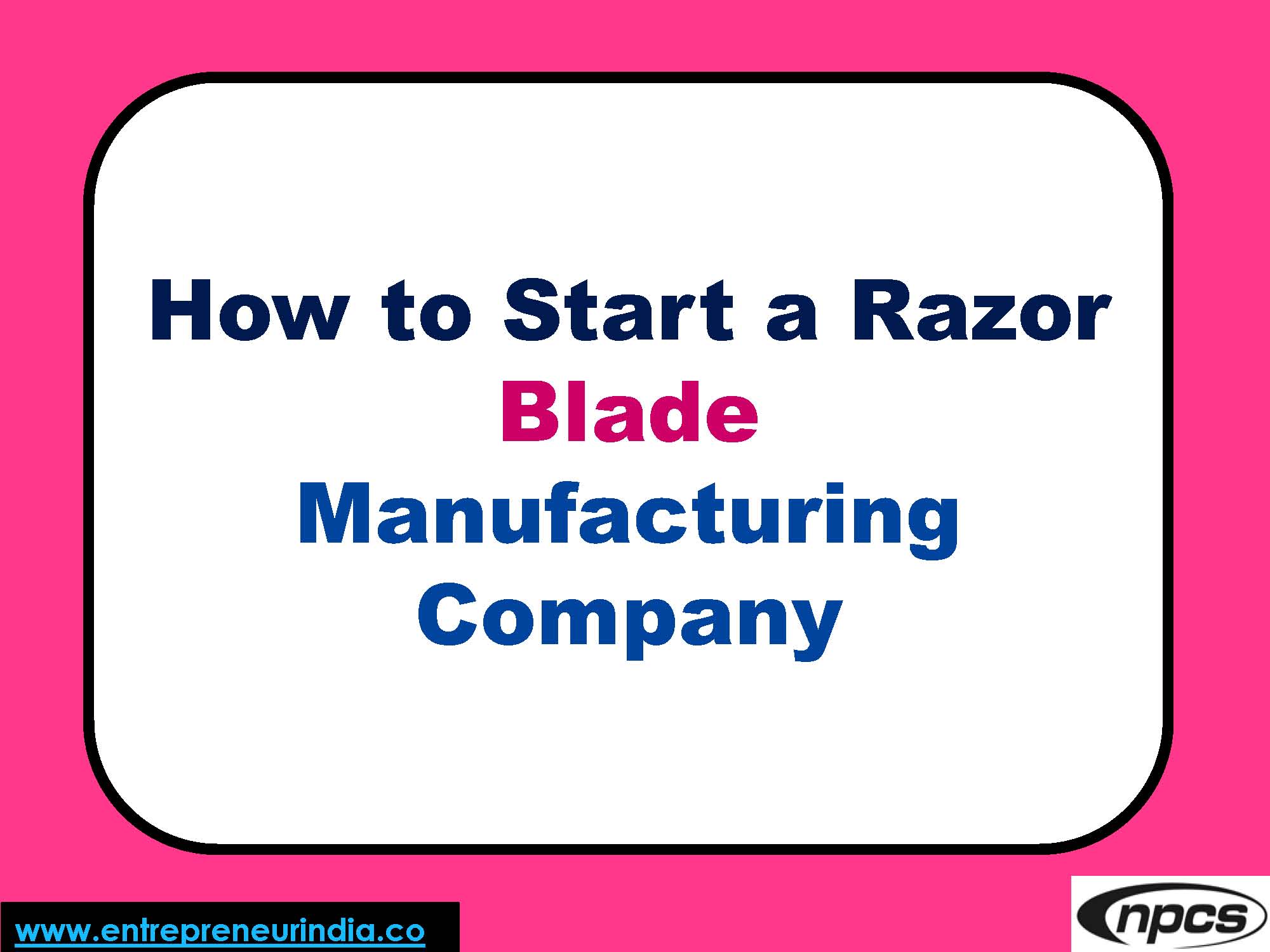
Starting a razor blade manufacturing company can be a rewarding venture, especially with the ever-growing demand for personal grooming products. Razor blades are an essential part of men’s and women’s grooming routines worldwide, and the market continues to grow due to increasing awareness of hygiene, evolving fashion trends, and disposable lifestyle habits. Moreover, the industry is no longer dominated by a few large brands—there is room for innovative, quality-driven startups that offer precision, affordability, and brand appeal. With the right investment, equipment, and marketing strategy, you can establish a profitable razor blade manufacturing company in this competitive but scalable space.
How to Start a Razor Blade Manufacturing Company
The razor blade manufacturing company involves precision engineering, metallurgy, and automated processes to produce sharp, durable, and safe blades for shaving. These blades are either integrated into disposable razors or sold as replaceable cartridges for reusable handles. The business has a broad customer base—ranging from individuals and salons to retailers, wholesalers, and e-commerce platforms.
As shaving is a high-consumption category with repeat purchases, it offers long-term growth potential. Additionally, innovations such as eco-friendly razors, multi-blade cartridges, and skincare-infused blades have opened new avenues in this segment.
Market Potential and Industry Outlook
The global razor blade market is expected to surpass $4 billion by 2028, driven by:
-
A rising population of working people
-
Increased grooming awareness in Tier-2 and Tier-3 cities
-
The rise of e-commerce and D2C grooming brands
-
Growing demand for affordable, high-performance blades
-
Trends toward subscription models and private-label products
India, with its large male population and increasing disposable income, is a key growth market. As a result, launching a razor blade manufacturing company now is both timely and strategic.
See More – Want to Start a Business in Karnataka
Types of Razor Blades You Can Manufacture
Based on your investment capacity and target market, you can produce:
1. Single Edge Blades
Used in safety razors and for industrial or salon applications.
2. Double Edge (DE) Blades
Traditional safety razor blades made of stainless steel. Still popular among shaving enthusiasts.
3. Cartridge Razor Blades
Multi-blade cartridges for modern razors (2-blade, 3-blade, 5-blade systems). Offers better margins and brand potential.
4. Disposable Razor Blades
Fixed blades molded into a plastic handle. Common in low-cost mass markets.
5. Women’s Razor Blades
Specially shaped and coated blades designed for sensitive skin and curves.
You can start with a single product type and expand as your brand grows.
Manufacturing Process of Razor Blades
The production process in a razor blade manufacturing company requires precision at every stage to ensure blade sharpness, safety, and longevity. Here’s a step-by-step overview:
1. Raw Material Selection
High-grade stainless steel strips (typically 0.1–0.2 mm thick) are used. For premium blades, titanium or chromium coatings may be applied.
2. Blanking
Steel strips are cut into small rectangular shapes (blade blanks) using stamping machines.
3. Heat Treatment
Blanks are hardened in heat treatment ovens to enhance strength and edge retention.
4. Grinding and Honing
Edges are ground using specialized machines to achieve razor-sharp finishes. Honing refines the cutting edge.
5. Coating
Blades are coated with materials like PTFE, Teflon, or ceramic to reduce friction and improve glide.
6. Cleaning and Inspection
Blades are ultrasonically cleaned and visually inspected for edge defects or surface irregularities.
7. Assembly and Packaging
Blades are loaded into cartridges or attached to razor handles. Finally, they are packed in hygienic, branded packaging.
Automation is used in most steps to ensure consistency and safety.
Machinery and Equipment Needed
A modern razor blade manufacturing company requires precision-engineered equipment, including:
-
Steel strip feeding machines
-
Blanking press
-
Heat treatment ovens (continuous or batch)
-
Edge grinding and honing machines
-
Coating machines (PTFE/Chromium coating)
-
Blade cleaning and polishing units
-
Cartridge assembly machines
-
Sterilization unit (optional)
-
Automatic packaging machines
-
Quality control and testing tools (microscopes, blade angle testers)
The quality of blades largely depends on grinding and coating equipment, so investing in top-grade machinery is crucial.
Setup Cost and Investment
Here’s a rough breakdown of the capital required to start a small-to-medium-scale razor blade manufacturing company:
| Expense Head | Estimated Cost (INR) |
|---|---|
| Land & Factory Building | ?50 lakh – ?1.5 crore |
| Machinery and Equipment | ?1 – ?3 crore |
| Raw Materials (steel, coatings) | ?20 – ?50 lakh |
| Labor and Operations | ?10 – ?30 lakh |
| Licensing & Certification | ?5 – ?10 lakh |
| Branding and Packaging | ?10 – ?25 lakh |
| Total Investment | ?2 – ?5 crore+ |
This estimate can vary based on automation, production scale, and product variety.
Licensing and Regulatory Requirements
You must comply with industry norms before launching a razor blade manufacturing company:
-
Company Registration (Pvt. Ltd., LLP, etc.)
-
Factory License under the Factories Act
-
MSME/Udyam Registration
-
GST Registration
-
Trademark Registration for brand protection
-
Pollution Control Board NOC
-
Import/Export Code (IEC) if selling overseas
-
ISO 9001 certification (optional but adds credibility)
-
BIS (Bureau of Indian Standards) approval for certain blade types
Adhering to hygiene and safety standards will help build consumer trust and gain retailer acceptance.
Branding, Packaging, and Positioning
Packaging is not just protection—it’s your brand’s first impression. Use:
-
Blister packs, cardboard sleeves, or plastic boxes
-
Clean design with brand logo, safety info, usage tips
-
Tamper-proof, hygienic, and eco-friendly materials
-
Bold product benefits: sharpness, safety, skin comfort, value-for-money
You can position your brand based on:
-
Price (affordable daily use)
-
Performance (precision shaving)
-
Specialty (for sensitive skin, women’s grooming)
-
Eco-conscious (recyclable blades or biodegradable handles)
Marketing and Distribution
Your success in the razor blade manufacturing company will depend greatly on your go-to-market strategy:
-
Distribute through FMCG wholesalers, medical stores, salons
-
Tie up with retail chains and supermarkets
-
Sell D2C via a website and online marketplaces (Amazon, Flipkart, Nykaa)
-
Offer subscriptions for refills and savings
-
Collaborate with influencers or grooming brands
-
Export to developing markets with growing personal care sectors
Brand recall, affordability, and performance are the keys to customer retention.
Also Read – Small & Medium Scale Business Ideas
Profit Margin and ROI
The razor blade manufacturing business offers attractive margins due to repeat usage and high volume:
-
Gross Profit Margin: 30%–50%
-
Net Profit Margin: 15%–25%
-
Break-even Period: 18–24 months
-
ROI Timeline: 2–3 years (depending on scale)
Margins improve significantly with brand recognition, customer loyalty, and direct-to-consumer channels.
Conclusion
Starting a razor blade manufacturing company is a smart move for entrepreneurs eyeing the growing personal care market. With the right technology, product quality, and branding, you can build a successful business that serves both domestic and international markets. While the initial setup requires precision investment, the long-term rewards—repeat sales, customer loyalty, and brand scalability—make it a high-potential opportunity.
Would you like help creating a detailed project report, equipment list, or a go-to-market strategy? I can assist you with tailored support at every stage of your startup journey.





